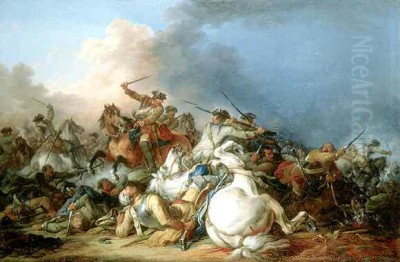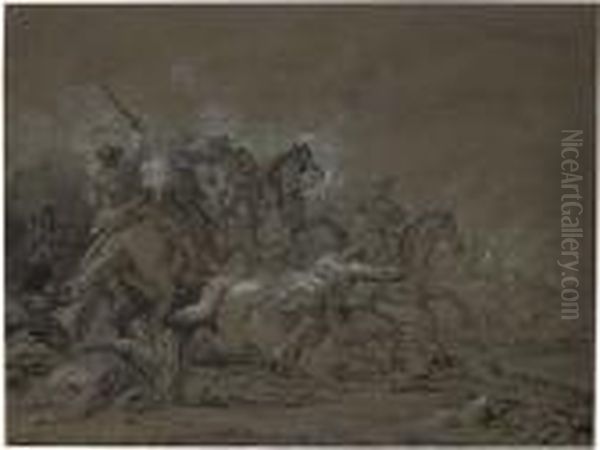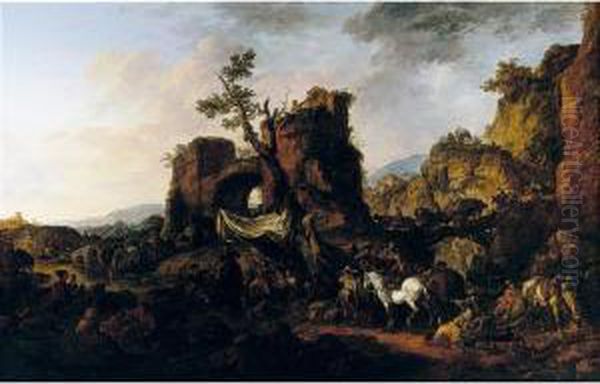Introduction: An Artist Between Venice and Paris

Francesco Giuseppe Casanova stands as a notable figure in the landscape of 18th-century European art. Born in London on December 27, 1727, into a family of Venetian actors, Zanetta Farussi and Gaetano Casanova, his life and career unfolded across several major European cultural centers. He was the younger brother of the infamous adventurer and writer Giacomo Casanova, whose renown often overshadowed Francesco's own considerable artistic achievements. Despite his London birth, his artistic roots were firmly planted in Venice, the city to which his family returned during his youth. His career, however, would largely flourish in Paris and Vienna, positioning him as an important conduit between Italian and French artistic traditions of the era. Primarily celebrated for his dynamic and detailed battle scenes, Casanova's oeuvre also encompassed landscapes, pastoral scenes, and genre paintings, showcasing a versatility influenced by both his Italian heritage and his experiences in France. He died in relative poverty in Paris on July 8, 1803, a stark contrast to the considerable reputation he enjoyed during his lifetime.
Formative Years and Venetian Training
Upon the Casanova family's return to Venice, the young Francesco was immersed in one of Europe's most vibrant artistic environments. The city, famed for its unique light and color, was home to masters like Canaletto and Francesco Guardi, whose depictions of the city defined the Veduta genre. It was within this stimulating atmosphere that Casanova began his formal artistic training. His most significant early teacher was Francesco Simonini, a painter who had established a strong reputation for his depictions of military engagements and equestrian subjects. Simonini himself drew inspiration from earlier masters of the battle genre, notably Jacques Courtois, known as 'Il Borgognone'. Under Simonini's tutelage, Casanova would have honed the essential skills for this demanding specialization: composing complex scenes involving numerous figures and horses in motion, capturing the drama and chaos of combat, and rendering military attire and equipment with accuracy. This foundational training in the Venetian tradition, with its emphasis on colorito (color and brushwork) and dramatic effect, would remain evident throughout his career, even as he absorbed other influences.
Parisian Studies and Academic Recognition

Seeking broader horizons and further refinement of his skills, Casanova traveled to Paris, the undisputed center of the European art world in the mid-18th century. There, he continued his specialization in battle painting by studying with Charles Parrocel, himself a member of a family renowned for depicting military subjects. Working in Paris exposed Casanova to the prevailing artistic currents, particularly the elegance and dynamism of the French Rococo style, exemplified by artists such as Antoine Watteau, François Boucher, and Jean-Honoré Fragonard. This exposure undoubtedly broadened his stylistic palette. A pivotal moment in his career occurred in 1757 when he was accepted as a member of the prestigious Académie Royale de Peinture et de Sculpture. This honor not only conferred significant status but also granted him the right to exhibit his works regularly at the official Paris Salon, providing crucial visibility and access to patronage. His acceptance signified his successful integration into the competitive Parisian art scene and marked the beginning of his rise to international prominence.
Master of the Battle Scene
Francesco Casanova's reputation largely rested on his mastery of the battle scene. This genre, popular among aristocratic and royal patrons who often commissioned depictions of their military triumphs or simply admired the dramatic spectacle, required a specific set of skills that Casanova possessed in abundance. His canvases typically teem with energy, depicting swirling mêlées of cavalry and infantry engaged in fierce combat. He excelled at capturing the dynamic movement of horses, a skill likely influenced by the Dutch master Philips Wouwerman, whose equestrian scenes were highly admired throughout Europe. Casanova's compositions are often complex, guiding the viewer's eye through the chaos with a strong sense of structure, likely learned from his French training under Parrocel. He paid meticulous attention to the details of uniforms, weaponry, and standards, lending an air of authenticity to his depictions. Dramatic use of light and shadow (chiaroscuro) heightened the intensity of the scenes, while his Venetian background often manifested in a rich and vibrant color palette. His celebrated work, Battaglia di cavalleria (Cavalry Battle), housed in the Louvre Museum in Paris, exemplifies these qualities, showcasing his ability to orchestrate large-scale, action-packed narratives on canvas. The series known as the "Four Storms" also highlights his capacity to infuse dramatic natural elements into his compositions.
Expanding Horizons: Landscapes and Genre Painting

While battle scenes formed the core of his output and fame, Francesco Casanova was by no means limited to this genre. He was also a capable painter of landscapes and genre scenes, demonstrating a broader artistic sensibility. His landscapes often reflect the pastoral ideals popular in the 18th century, sometimes depicting tranquil countryside settings, perhaps influenced by fellow Venetian landscape painters like Francesco Zuccarelli or Marco Ricci. However, his time in France also exposed him to the work of landscape artists like Claude-Joseph Vernet, known for his atmospheric effects and dramatic seascapes, which may have informed Casanova's approach to light and atmosphere in his own landscape work. Furthermore, he produced charming genre paintings, such as Hunt Breakfast, which depict scenes of everyday aristocratic or rural life. These works often display a lighter touch and palette compared to his battle pieces, incorporating elements of Rococo elegance and charm learned during his time in Paris. This versatility demonstrates his ability to adapt his style to different subjects, moving beyond the purely martial themes for which he was best known.
Artistic Style: A Synthesis of Traditions
Francesco Casanova's artistic style represents a fascinating synthesis of his native Venetian heritage and the French influences he absorbed during his formative years in Paris. From Venice, particularly from his teacher Simonini and the broader tradition including artists like Guardi, he retained a sensitivity to color, light, and expressive brushwork. The vibrancy and atmospheric quality often found in Venetian painting permeate many of his works. From his French training under Parrocel and his exposure to the Rococo masters like Watteau and Fragonard, he gained a sense of compositional structure, elegance, and dynamic movement, particularly evident in the fluid lines and sophisticated arrangements of his figures. Some sources have anachronistically mentioned "Impressionism" in relation to his work; while he was certainly not an Impressionist (a movement that arose a century later), it's possible that his advanced handling of light effects, atmospheric perspective, and perhaps passages of broken brushwork seemed remarkably modern to later observers, prefiguring techniques that would be more fully explored much later. His true achievement lies in the successful fusion of these distinct traditions, creating a style that was both robust and refined, appealing to patrons across Europe. He skillfully balanced the Venetian emphasis on color and atmosphere with the French inclination towards structure and graceful composition.
An International Career and Patronage
Following his acceptance into the French Academy, Casanova's career gained significant momentum. He became one of the most sought-after painters of battle scenes in Europe, a genre that held particular appeal for the ruling elites who wished to commemorate their military exploits or simply adorn their palaces with dramatic and prestigious artworks. While specific patrons are not always detailed in readily available sources, it is known that he enjoyed favor in various European courts. His success was not confined to Paris; he also spent considerable time working in Vienna, the capital of the Habsburg Empire, further cementing his international reputation. His presence in cities like Dresden is also noted, where he may have interacted with artists active there, such as the portraitist Marcello Bacciarelli, who worked extensively for the Polish court but was active in Dresden earlier. This demand from high-status patrons across different countries underscores the widespread appeal of his work and his ability to navigate the complex networks of European courtly society, even if this success did not translate into lasting personal wealth. His paintings entered numerous important collections, ensuring his visibility and influence.
Connections and Contemporaries
Francesco Casanova's career placed him within a rich network of artistic exchange. His primary teachers, Francesco Simonini in Venice and Charles Parrocel in Paris, provided direct lineage to the established tradition of battle painting, itself influenced by figures like Jacques Courtois ('Il Borgognone') and Philips Wouwerman. In Venice, he was a contemporary of the great Veduta painters Canaletto and Francesco Guardi, as well as landscape and genre painters like Francesco Zuccarelli and Marco Ricci, whose work formed the backdrop to his early development. In Paris, he entered an art world dominated by Rococo masters Antoine Watteau, François Boucher, and Jean-Honoré Fragonard, whose elegance likely influenced his style. He also worked alongside other successful contemporaries specializing in related genres, such as the landscape and marine painter Claude-Joseph Vernet, the animal and hunt painter Jean-Baptiste Oudry, and versatile figures like Carle Van Loo. His time in Central Europe potentially brought him into contact with artists like Marcello Bacciarelli in Dresden or others active at the Viennese court. This web of connections highlights Casanova's position within the mainstream of European art, absorbing and contributing to the dominant styles and genres of his time.
Later Life, Poverty, and Legacy
Despite the considerable fame and patronage Francesco Casanova achieved during his peak years, his later life was marked by financial difficulties. The reasons for this decline into poverty are not entirely clear but may relate to changing tastes, the upheavals of the French Revolution and its aftermath, or perhaps personal financial mismanagement. It presents a poignant contrast between his artistic reputation and his personal circumstances. He died in Paris in 1803, relatively impoverished. Nevertheless, his artistic legacy endured. He remains recognized as a significant and highly skilled practitioner of battle painting, admired for his dynamic compositions, technical proficiency, and his ability to convey the drama of combat. More broadly, his career exemplifies the cosmopolitan nature of 18th-century European art, showcasing how artists moved between centers like Venice and Paris, blending different national traditions. He served as an important link, bringing elements of Venetian color and dynamism to the structured elegance often favored in France. While perhaps not reaching the absolute first rank of artists like his contemporary Fragonard or his Venetian predecessors like Tiepolo, Francesco Casanova holds a secure place in art history as a master of his chosen genres and a notable figure in the artistic exchanges of his era.